After just a week in Michigan, Tony and I hit the road for a little romantic get-away. We loaded our bikes on the rental car and drove about four hours north to Mackinaw City, where we parked the car and rolled our bikes onto a ferry. The short ride treated us to views of Lake Michigan to the west and Lake Huron to the east.
At the ferry dock.
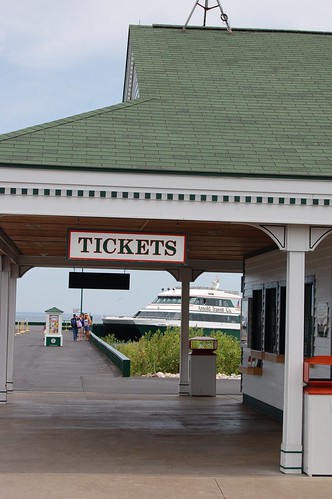
Disembarking on the island was like stepping back in time … or maybe more accurately, stepping in to a studio lot for a movie about horse-loving, bike-riding fudge makers. Our hotel’s porter greeted us at the boat and transported our bag to the hotel. We hopped on our bikes for the short ride along the harbor to our quaint weekend home, the Inn on Mackinac.
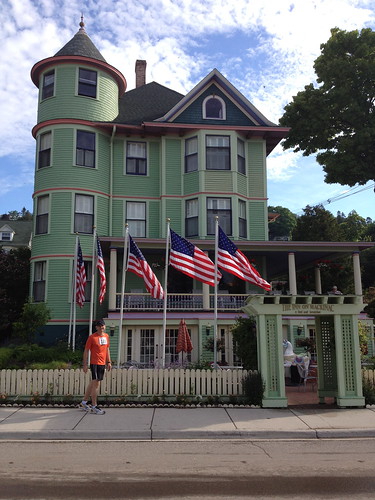
After settling in, we walked back to Main Street for an alfresco lunch at the Pink Pony, followed by a stroll through the neighborhood.
Lunch at the Pink Pony. We liked this place so much, we ate here again the next day.

Automobile-free since 1898, Mackinac Island has retained its turn-of-the-century charm. Juxtaposed against modern suburban developments and their cookie-cutter houses, the island’s homes range from dainty cottages with lace curtains and window boxes of red geraniums to elegant Victorian-style mansions – all turrets, verandas and stained glass. Horse-drawn carriages line the street awaiting fares, and tourists get around on rented bikes.
Home to a flourishing fur trade in the 1820s and later a commercial fishing hub, Mackinac Island’s biggest industry these days seems to be fudge. Since the first “Candy Kitchen” opened in 1889, fudge has been a popular souvenir. We popped in to several shops for samples. My favorite: dark chocolate with cherries and walnuts. (You can join a “fudge crawl” to the 14 candy stores, but that just sounded nauseating to me.)
We specifically picked this weekend to visit Mackinac Island for the Lilac Festival. Someone forgot to tell the lilacs, though. They had already bloomed and dropped their blossoms by the time the festival rolled around. Bummer.
Tony and I were registered for the Lilac Festival 10K on Saturday morning. Fit and raring to go, Tony was looking forward to the run. Flabby and nursing a wonky neck, I was contemplating a big breakfast instead. That morning, however, I decided to do a 10-kilometer STROLL, stopping frequently to take photos and relishing the bright blue sky, fresh pine-scented air, and forest and waterfront trails. About 10 minutes into my walk and after snapping a few pictures, my reclusive competitive spirit suddenly surfaced and I felt the overpowering urge to kick everyone’s butts in this race. Totally out of shape, I knew I couldn’t run, but I speed-walked like a lunatic. By the time I loped across the finish line, I had pulled every muscle from the arch in my foot to my already-debilitated cervical spine.
The runners got a head-start on the walkers.

The walkers take off like a herd of turtles.

Photos I took while I was still “strolling.”
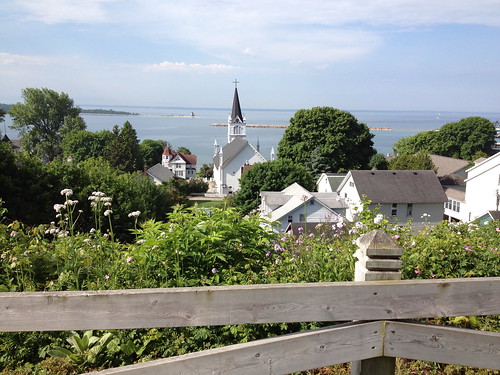
Tony was happy with his time, too. (I dropped a cookie and spilled my water on someone trying to get this shot, so it’s a bit blurry.)
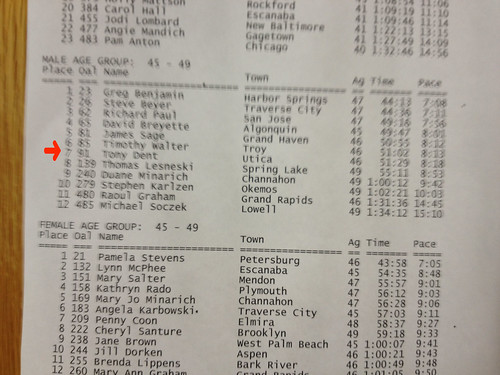
Much to Tony’s chagrin, I couldn’t possibly visit Mackinac Island and NOT take a carriage tour. So that’s what we did. It turned out to be quite interesting and informative. The island’s recorded history dates to 1,000 B.C., when Native Americans fished there for trout, pike, sturgeon, herring and whitefish. Early French settlers in the region named the hump-backed island Michilimackinac, which allegedly means “place of the great turtle.” The name was eventually shorted to Mackinac (pronounced Mack-in-aw). A French military outpost on the mainland was moved to Mackinac Island in 1761 when British soldiers took control. The fort and island became U.S. territory after the American Revolution, but the British recaptured the fort during the War of 1812. Peace negotiators restored the island and Fort Mackinac to the United States two years later.
We switched to a different carriage to tour Mackinac Island State Park (which covers 80 percent of the island), as well as some historical and natural landmarks.
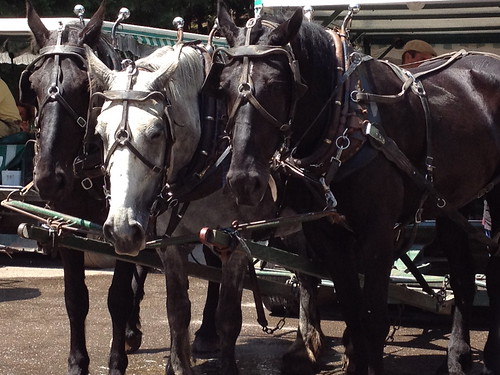
We opted to end our tour at the fort, which I LOVED! It sounds crazy, I know, but almost any military fort reminds me of my upbringing. The various buildings featured excellent interpretive displays with plenty of photographs, artifacts and stories from the 1800s. We visited the one-room schoolhouse, soldiers’ barracks, officers’ quarters, the quartermaster’s storehouse, the post hospital and the post bathhouse, which was constructed in 1885 during a “hygiene fever.” The post doctor implemented a revolutionary policy requiring soldiers to bathe at least once a week in the cast iron bath tubs.

I am more than a little fascinated with medical history, so one of my favorite characters from Fort Mackinac lore is Dr. William Beaumont. Here’s the story, well told on Wikipedia:
On June 6, 1822, an employee of the American Fur Company on Mackinac Island, named Alexis St. Martin, was accidentally shot in the stomach by a discharge of a shotgun loaded with a duck shot from close range that injured his ribs and his stomach. Dr. Beaumont treated his wound, but expected St. Martin to die from his injuries. Despite this dire prediction, St. Martin survived – but with a hole, or fistula, in his stomach that never fully healed. Unable to continue work for the American Fur Company, he was hired as a handyman by Dr. Beaumont.
By August 1825, Beaumont had been relocated to Fort Niagara in New York, and Alexis St. Martin had come with him. Beaumont recognized that he had in St. Martin the unique opportunity to observe digestive processes. Dr. Beaumont began to perform experiments on digestion using the stomach of St. Martin. Most of the experiments were conducted by tying a piece of food to a string and inserting it through the hole into St. Martin’s stomach. Every few hours, Beaumont would remove the food and observe how well it had been digested. Beaumont also extracted a sample of gastric acid from St. Martin’s stomach for analysis. …Beaumont used samples of stomach acid taken out of St. Martin to “digest” bits of food in cups. This led to the important discovery that the stomach acid, and not solely the mashing, pounding and squeezing of the stomach, digests the food into nutrients the stomach can use; in other words, digestion was primarily a chemical process and not a mechanical one.
In early 1831, Dr. Beaumont conducted another set of experiments on St. Martin’s stomach, ranging from the simple observation of normal digestion to the effects that temperature, exercise and even emotions have on the digestive process.
Beaumont published the account of his experiments in 1838, as Experiments and Observations on the Gastric Juice, and the Physiology of Digestion. He and St. Martin parted ways, with Beaumont eventually going to St. Louis, Missouri, and St. Martin to his home in Quebec province, Canada. Off and on for the next twenty years, Beaumont tried to get St. Martin to move to St. Louis, but the move never occurred. Beaumont died in 1853 as a result of slipping on ice-covered steps.
Sunday morning, we rose with the sun for a bike ride on Mackinac Island’s perimeter highway M-185.
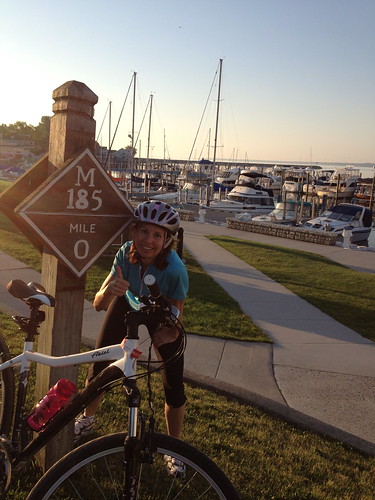
Whew! We rode around the ENTIRE ISLAND!!!

(OK, the “entire island” is only eight miles…)
After breakfast, we put on our grown-up clothes and walked to the Grand Hotel. Built in 1887 for summer visitors, the hotel exudes posh nostalgia (especially if you squint enough to blur the bored teens with saggy jeans and dads with bellies hanging over their cargo shorts). The movie “Somewhere in Time” was filmed at the Grand. Remember? Christopher Reeve’s character goes back in time and meets the woman of his dreams, played by Jane Seymour, but then he finds a modern-day penny in the pocket of his 1912 pants and is transported back to the 1970s. Of course, I felt compelled to re-enact the penny scene for Tony more than once. He loved it. Not really.
After our visit to the Grand, we decided to head back to reality on the next ferry. Maybe we’ll try to catch the lilacs in bloom next summer.


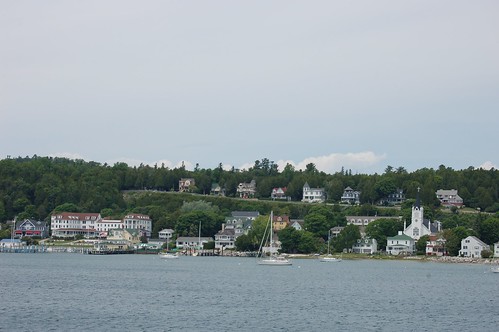
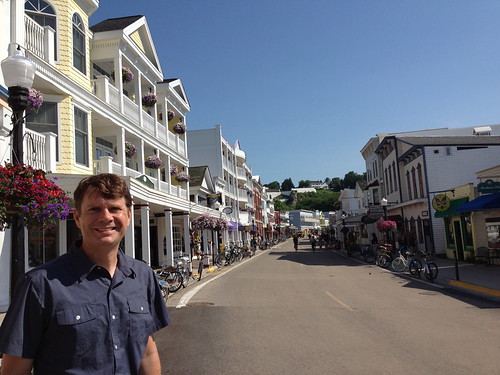


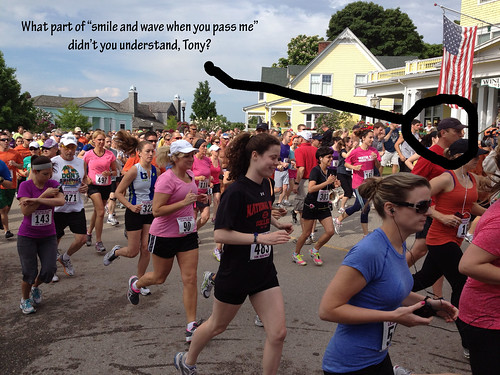
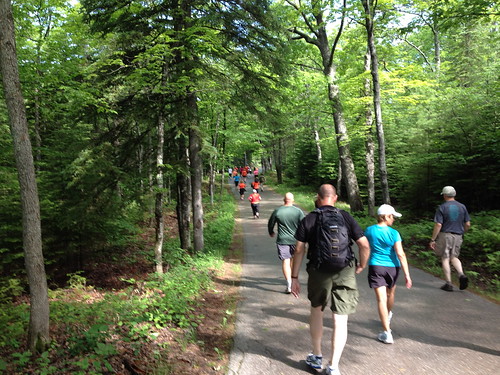

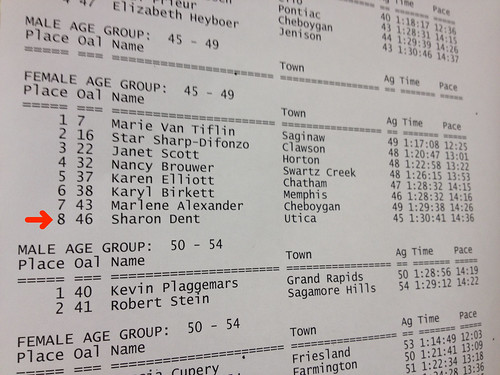
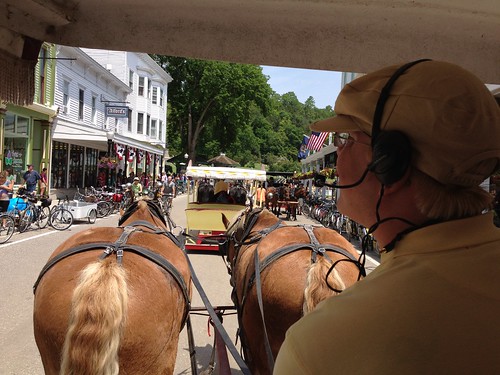
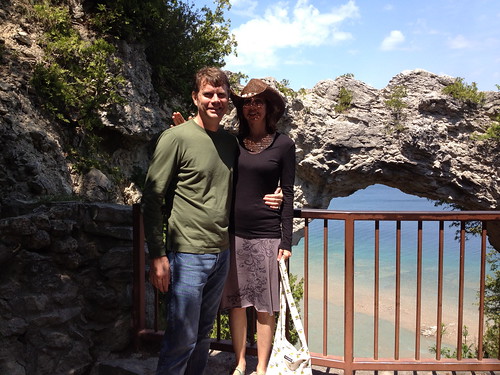
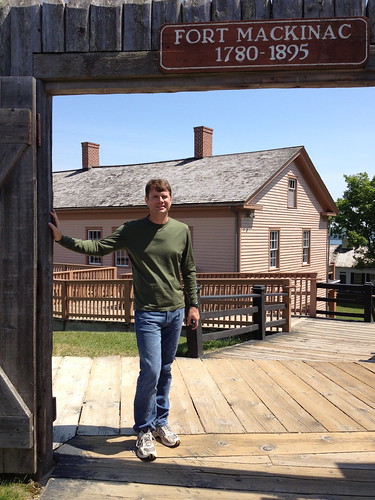
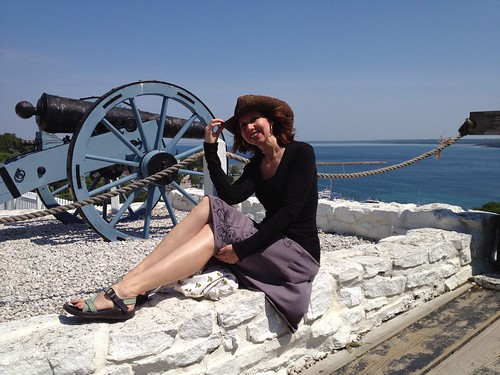
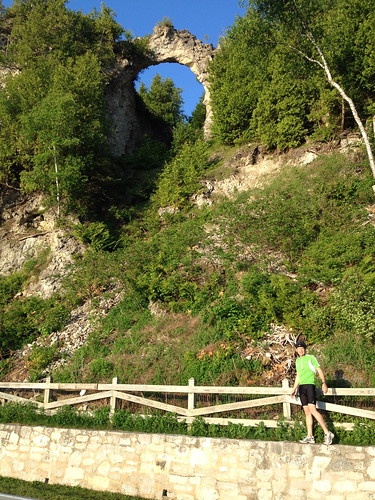

way to go Dents!
Did you notice there aren’t any street signs in the touristy parts of the island? And did you say howdy to the poor college journalism interns?
Wow, I’d read many things about Fort Mackinac, having been a historical interpreter for two summers at the “just-down-the-road” Fort St. Joseph N.H.S. in northern Ontario, but I guess I never believed it was as good as they made it out to be. Add to that the obvious tourist infrastructure, and I can completely understand why Michiganers were always disappointed with their visit to St. Joseph’s Island. Now Mackinac Island is on my Must-see list, thanks!